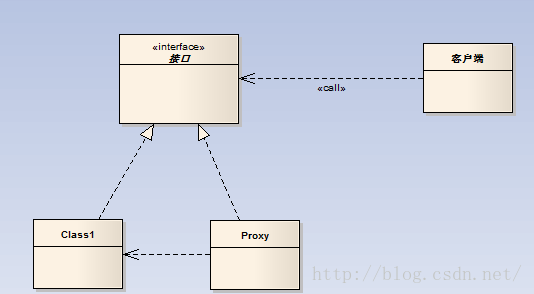Java在JDK1.3的时候引入了动态代理机制、可以运用在框架编程与平台编程时候捕获事件、审核数据、日志等功能实现,首先看一下设计模式的UML图解:

当你调用一个接口API时候,实际实现类继承该接口,调用时候经过proxy实现。
在Java中动态代理实现的两个关键接口类与class类分别如下:
java.lang.reflect.Proxy
java.lang.reflect.InvocationHandler
我们下面就通过InvocationHandler接口来实现动态代理过程,通过Proxy接口创建
一个代理类,然后测试完整的程序。要实现演示Demo需要如下几步:
一:首先定义我们自己的POJO对象接口类IExample与IUser
|
1
2
3
4
5
6
7
8
9
10
11
12
13
|
package com.example.pojo; public interface IExample { public void setName(String name); public String getName(); public void setDesc(String description); public String getDesc(); } |
|
1
2
3
4
5
6
7
8
9
10
11
12
13
|
package com.example.pojo; public interface IUser { public void setUserID(String userID); public String getUserID(); public void setUserName(String userName); public String getUserName(); } |
二:实现我们自己InvocationHandler接口,其中map我用来存储POJO对象的数据,这样做的好处是POJO接口无需再创建实现类,只有定义接口就可以通过代理直接使用该类,这在实际项目开发中非常有用。
|
1
2
3
4
5
6
7
8
9
10
11
12
13
14
15
16
17
18
19
20
21
22
23
24
25
26
27
28
29
30
31
32
33
34
35
36
37
38
39
40
|
package com.example.reflection; import java.lang.reflect.InvocationHandler; import java.lang.reflect.Method; import java.lang.reflect.Proxy; import java.util.HashMap; import java.util.Map; public class MyProxyView implements InvocationHandler { private Map<Object, Object> map = null; public static Object newInstance(Class[] interfaces) { return Proxy.newProxyInstance(MyProxyView.class.getClassLoader(), interfaces, new MyProxyView()); } private MyProxyView() { this.map = new HashMap<Object, Object>(); } @Override public Object invoke(Object proxy, Method method, Object[] args) throws Throwable { Object result = null; String methodName = method.getName(); if (methodName.startsWith("get")) { String name = methodName.substring(methodName.indexOf("get") + 3); return map.get(name); } else if (methodName.startsWith("set")) { String name = methodName.substring(methodName.indexOf("set") + 3); map.put(name, args[0]); return null; } else if (methodName.startsWith("is")) { String name = methodName.substring(methodName.indexOf("is") + 2); return (map.get(name)); } return result; } } |
三:通过Proxy方法初始化代理得到POJO对象,运行与测试:
|
1
2
3
4
5
6
7
8
9
10
11
12
13
14
15
16
17
18
19
20
21
22
23
24
25
26
27
28
|
package com.example.reflection; import com.example.pojo.IExample; import com.example.pojo.IUser; public class TextProxy { public static void main(String[] args) { IExample example = (IExample)MyProxyView.newInstance(new Class[]{IExample.class}); IUser user = (IUser)MyProxyView.newInstance(new Class[]{IUser.class}); // aduit bean 1 example.setName("my example"); example.setDesc("my proxy example"); // aduit bean 2 user.setUserID("jia20003"); user.setUserName("gloomyfish"); System.out.println("exmaple name : " + example.getName()); System.out.println("exmaple desc : " + example.getDesc()); System.out.println(); System.out.println("user ID : " + user.getUserID()); System.out.println("user name : " + user.getUserName()); } } |
四:运行结果如下:
|
1
2
3
4
5
|
exmaple name : my example exmaple desc : my proxy example user ID : jia20003 user name : gloomyfish |
Java动态代理方式对框架编程非常重要无论是在Web端还是桌面端
而真正把这种技术发扬光大的则是spring框架。
感谢阅读,希望能帮助到大家,谢谢大家对本站的支持!
原文链接:http://blog.csdn.net/jia20003/article/details/49930043

















